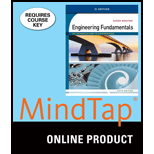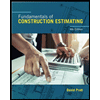
MindTap Engineering, 2 terms (12 months) Printed Access Card for Moaveni's Engineering Fundamentals, SI Edition, 5th
5th Edition
ISBN: 9781305110250
Author: MOAVENI, Saeed
Publisher: Cengage Learning
expand_more
expand_more
format_list_bulleted
Concept explainers
Question
Chapter 7, Problem 1P
To determine
Estimate the dimensions of the given objects. Compare the estimated value with actual dimension of the object.
Check the valuing capacity of dimension from the comparison.
Expert Solution & Answer
Explanation of Solution
Use the following procedure to estimate and compare with actual dimension of the object:
- Value the dimensions of the given object without using any measuring device. This is called estimated values.
- List the estimated values in Table 1.
- Measure the actual dimension of the object by using the measuring instruments.
- List the actual values of the objects in Table 1.
- Compare the estimated value with measured value.
- Calculate the difference between the estimated and actual value.
Provide the estimated value, actual dimensions, and the difference between each object as shown in table 1.
| Object | Estimated values | Measured values | Difference | |||
| This book | ||||||
| A pen or pencil | ||||||
| A laptop computer (closed) | ||||||
| A 12-fl.-oz soda can | ||||||
| The distance from home to school | ||||||
| A dollar bill | ||||||
| The height of your engineering building | ||||||
| Wingspan of a Boeing 747 | ||||||
Table 1
Refer to Table 1:
The difference between the estimated and calculated value is minimum. The accuracy of estimated value is moderate.
Want to see more full solutions like this?
Subscribe now to access step-by-step solutions to millions of textbook problems written by subject matter experts!
Students have asked these similar questions
Seasoned engineers are good at estimating physical values without using tools. Therefore, you need to begin developing a “feel” for the sizes of various physical quantities. This exercise is intended to help you develop this ability. Using the table below, first estimate the dimensions of the given objects. Next measure, or look up, the actual dimensions of the objects, and compare them to your estimated values. How close are your estimations? Do you have a “feel” for units of length yet?
Calculate the required area of the column,Ag, and give your answer in inches squared (in^2).
A box is measured at 24.0” long, 12.55” wide and 8 inches tall. What is the volume of the box in cubic inches? Use appropriate significant figures.
Chapter 7 Solutions
MindTap Engineering, 2 terms (12 months) Printed Access Card for Moaveni's Engineering Fundamentals, SI Edition, 5th
Ch. 7.2 - Prob. 1BYGCh. 7.2 - Prob. 2BYGCh. 7.2 - Prob. 3BYGCh. 7.2 - Prob. 4BYGCh. 7.2 - Prob. 5BYGCh. 7.2 - What does strain represent?Ch. 7.2 - Prob. BYGVCh. 7.5 - Prob. 1BYGCh. 7.5 - Describe two different methods that you can use to...Ch. 7.5 - Prob. 3BYG
Ch. 7.5 - Prob. 4BYGCh. 7.5 - Prob. 5BYGCh. 7.5 - Prob. BYGVCh. 7 - Prob. 1PCh. 7 - Prob. 2PCh. 7 - Prob. 3PCh. 7 - Prob. 4PCh. 7 - Prob. 5PCh. 7 - Prob. 6PCh. 7 - Prob. 7PCh. 7 - Prob. 8PCh. 7 - Prob. 9PCh. 7 - Prob. 10PCh. 7 - Investigate the diameter of the electrical wire...Ch. 7 - Prob. 12PCh. 7 - Prob. 13PCh. 7 - Prob. 15PCh. 7 - Prob. 17PCh. 7 - Using area as your variable, suggest ways to cool...Ch. 7 - Prob. 19PCh. 7 - Prob. 20PCh. 7 - Prob. 21PCh. 7 - Prob. 22PCh. 7 - Prob. 23PCh. 7 - Prob. 24PCh. 7 - Prob. 25PCh. 7 - Prob. 26PCh. 7 - Prob. 27PCh. 7 - Prob. 28PCh. 7 - Prob. 30PCh. 7 - Prob. 31PCh. 7 - Prob. 32PCh. 7 - Prob. 33PCh. 7 - Prob. 34PCh. 7 - Prob. 35PCh. 7 - Prob. 36PCh. 7 - Prob. 37PCh. 7 - Prob. 38PCh. 7 - Prob. 39PCh. 7 - Prob. 40PCh. 7 - Prob. 41PCh. 7 - Prob. 42PCh. 7 - A 10 cm long rectangular bar (when subjected to a...Ch. 7 - Prob. 44PCh. 7 - Prob. 45PCh. 7 - Prob. 46PCh. 7 - Prob. 47PCh. 7 - Prob. 48PCh. 7 - Prob. 49PCh. 7 - Prob. 50P
Knowledge Booster
Learn more about
Need a deep-dive on the concept behind this application? Look no further. Learn more about this topic, civil-engineering and related others by exploring similar questions and additional content below.Similar questions
- Calculate the volume of material used in making 100 ft of 4-in type K, L & M copper tubing, respectively. All three types have an outer diameter of 4.125 in, but the inner diameters are 3.857 in for K, 3.897 in for L, and 3.935 in for M. Show your calculations and results.arrow_forwardDetermine the density, specific volume, and volume of an object that weighs 3N 2 in water and 4N in oil with specific gravity of 0.83 draw figurearrow_forwardthe answer given is 31.9kg. How to calculate the mass of a 2 m length of schedule 40 pipe, nominal size 101.6?arrow_forward
- An imported cylindrical tank has a radius of 35 centimeters and is2.15 meters long. What is the volume of the tank?arrow_forwardWhat should the diameter of the steering wheel be? Each of the arrows you see stand for force F and each should be no greater than 3 lb. Calculate the couple momentarrow_forwardDetermine appropriateness (Good OR Poor) of the given dimensions (from 1 to 15) shown in Figure below. If your answer is Poor, try to think about the reason and how to give a better dimension. Please write your answer like this --> (1) Good / (1) Poor because....arrow_forward
- ANSWER THE FOLLOWING PROBLEM QUESTION "Loaded beam". SHOW YOUR SOLUTION AND BOX THE FINAL ANSWER DO NOT FORGET TO ROUND OFF AND USE 2 DECIMAL PLACES AS YOUR FINAL ANSWER. Thank you for your help. TAKE NOTE: A4 MEANS AREA 4, A5 MEANS AREA 5 A6 MEANS AREA 6arrow_forwardFill out the table below. Show your solutions. Round off all numerical values to three decimal places.arrow_forward
arrow_back_ios
arrow_forward_ios
Recommended textbooks for you
 Engineering Fundamentals: An Introduction to Engi...Civil EngineeringISBN:9781305084766Author:Saeed MoaveniPublisher:Cengage Learning
Engineering Fundamentals: An Introduction to Engi...Civil EngineeringISBN:9781305084766Author:Saeed MoaveniPublisher:Cengage Learning Fundamentals Of Construction EstimatingCivil EngineeringISBN:9781337399395Author:Pratt, David J.Publisher:Cengage,
Fundamentals Of Construction EstimatingCivil EngineeringISBN:9781337399395Author:Pratt, David J.Publisher:Cengage,

Engineering Fundamentals: An Introduction to Engi...
Civil Engineering
ISBN:9781305084766
Author:Saeed Moaveni
Publisher:Cengage Learning

Fundamentals Of Construction Estimating
Civil Engineering
ISBN:9781337399395
Author:Pratt, David J.
Publisher:Cengage,